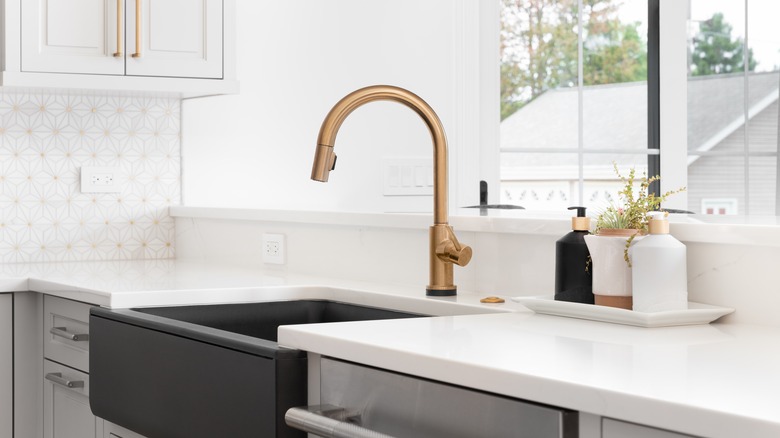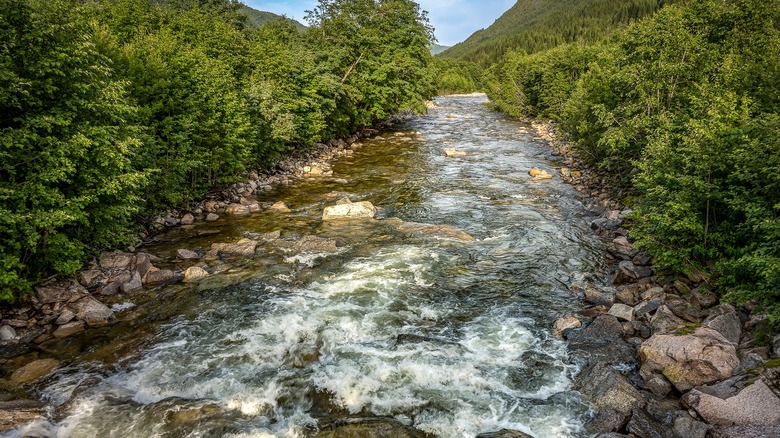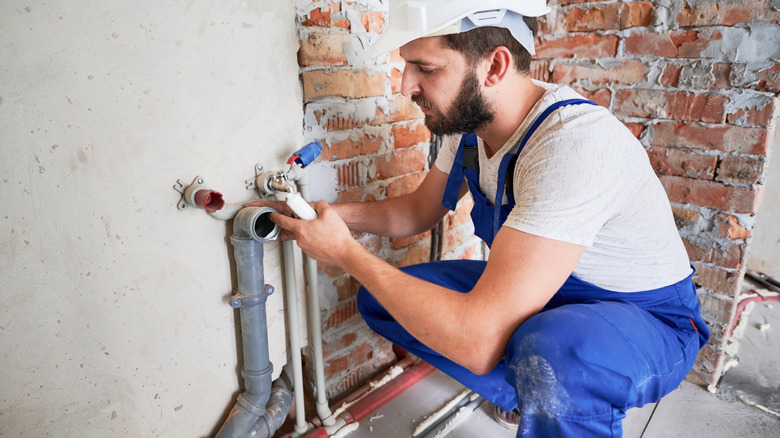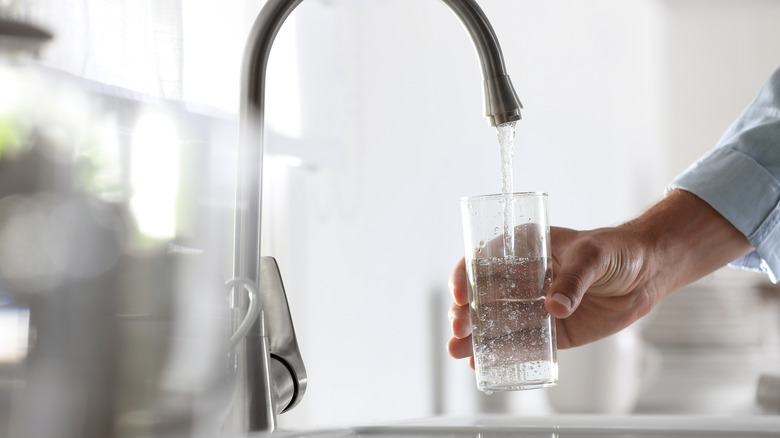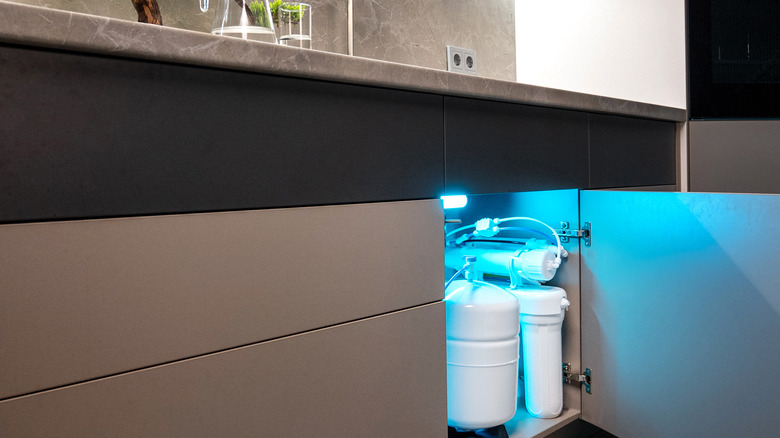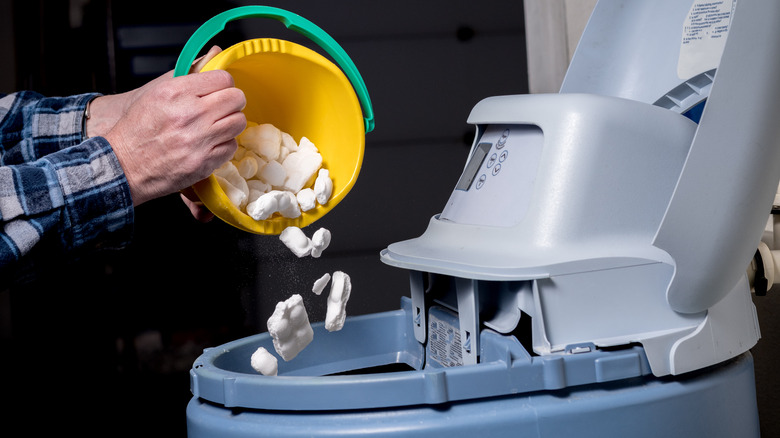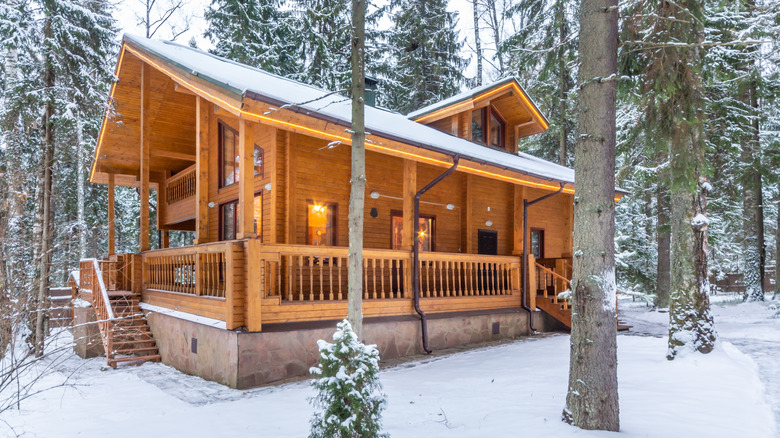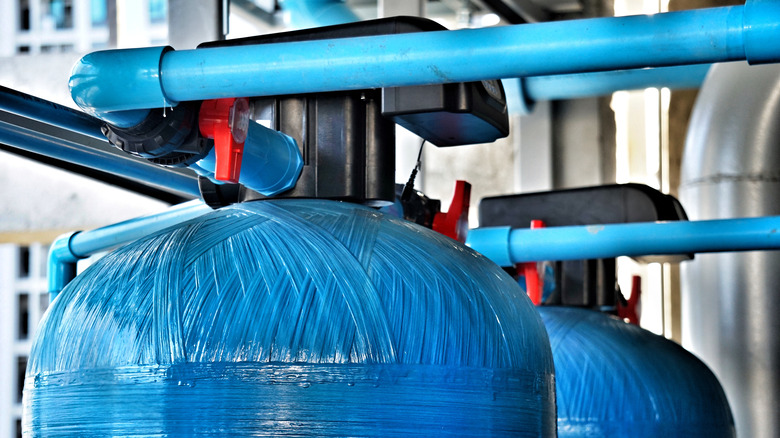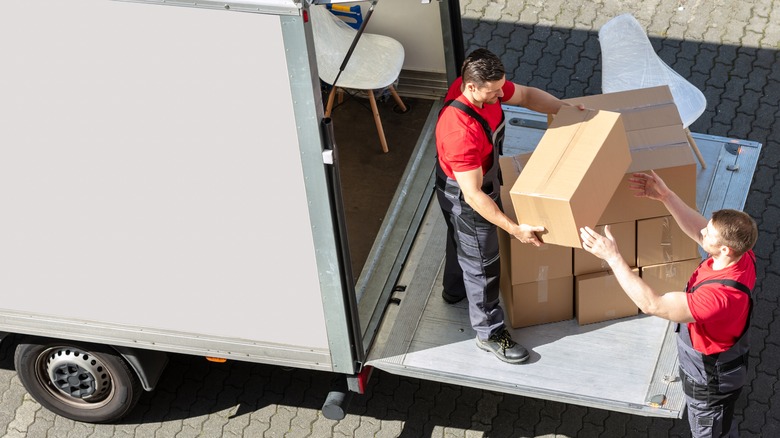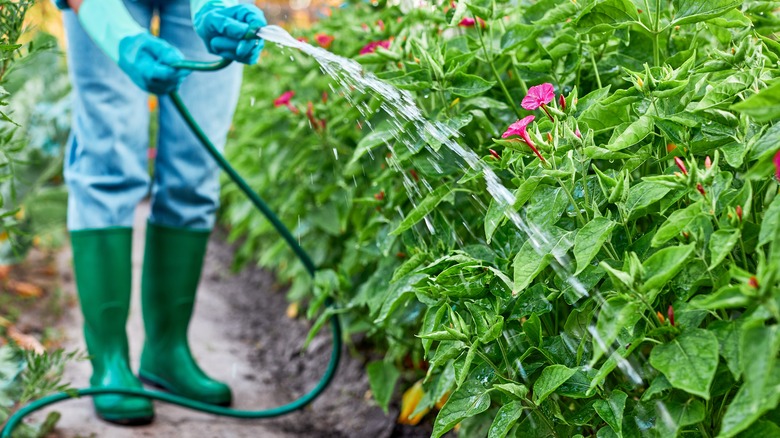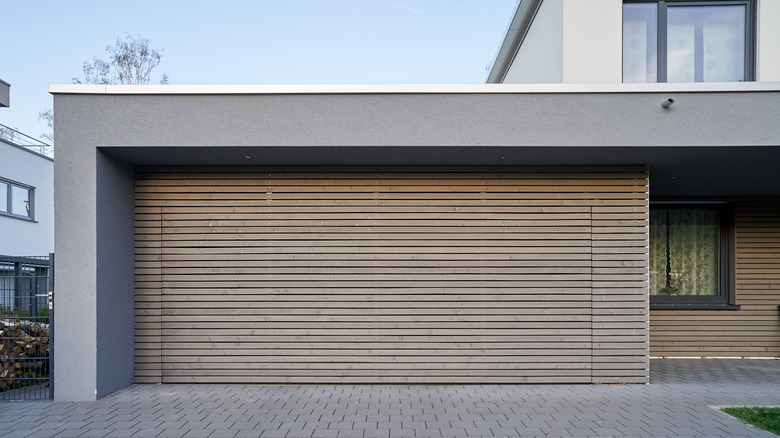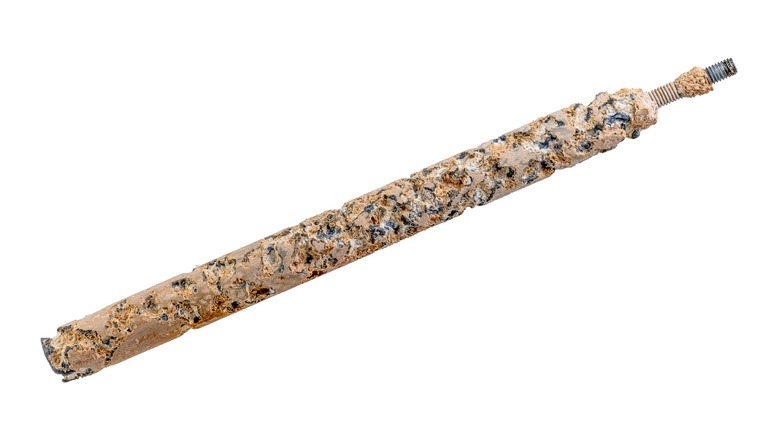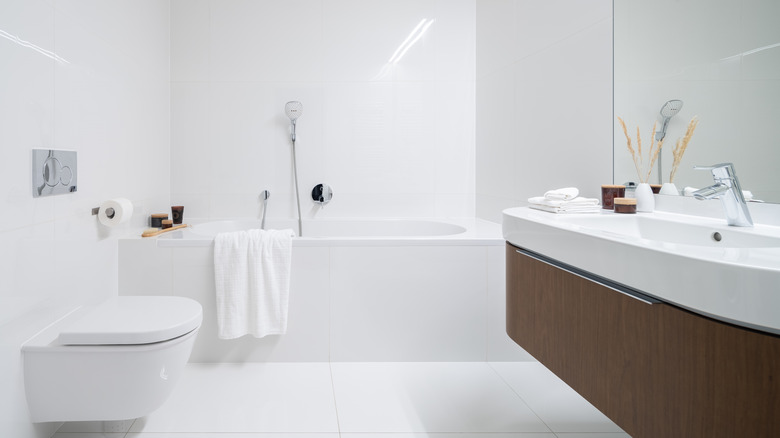The Hidden Downsides To Water Softeners
Many people invest in no-brainer home appliances to save time and money such as dishwashers, washing machines, and coffee makers. Some would add water softeners to this list. While a water softener won't shave minutes off your daily routine, it can save you time and money in the long term on pipe and appliance maintenance, particularly in homes built from approximately 1945 to 1975, as per The 71 Percent. This is because softening your water helps eliminate limescale — the nasty culprit for bathtub rings, clogged pipes, and soap scum, explains Aquasana. Many people also like how softer water makes their skin and clothes feel, not to mention needing to use up to 70% less soap (via U.S. Water Systems).
85% of America has hard water, mostly occurring in the southwest, plains, and midwest (via Whirlpool). Water softeners work by removing the minerals that cause hard water, including calcium and magnesium. They do this by using resin beads and sodium tablets that have negatively and positively charged ions to create an exchange of minerals — basically, switching out calcium and magnesium for sodium.
This article will focus on salt-based ion exchange water softeners. They can last for 10 to 15 years, range from $500 to $6,000 (including professional installation), and are the most prevailing models with the best results (via Angi). However, aside from the initial cost, there are under-the-radar issues, including water waste and water contents, that everyone should consider before buying a water softener. Here are some hidden downsides.
Water softeners can pose environmental concerns
Water softeners have put conservationists on alert because they use excess water and discharge a brine solution into sewer systems and waterways. According to Moore Heating, for every 1,000 gallons of water cycling through your water softener, up to 120 gallons go to waste. Put another way, water softeners use about 8,000 gallons of extra water per year, reports Enviro Water Products.
According to APEC Water Systems, the sodium chloride discharge flowing out of water softeners and into waterways and irrigation channels threatens numerous elements in the biosphere, including marine animals and soil composition. Some states and communities have banned or regulated salt-based softeners over environmental concerns, including California, Texas, Connecticut, Michigan, and Wisconsin, reports HydroFlow USA. Additionally, municipal wastewater facilities aren't set up to remove extra sodium, thus creating a food supply issue when crops relying on that wastewater become degraded by salt-laden irrigation. Desalination plants are too expensive for many municipalities to install, reports Life Source Water Systems. An alternative for homeowners is to use a water conditioner, which contains no salt, doesn't use extra water, and is carbon-neutral, recommends U.S. Water Systems. If you use a lot of water outdoors, consider bypassing your water softener with one or two exterior spigots to reduce the amount of water going through your softener (via PerfectWater).
There are hidden and ongoing costs of owning a water softener
Sodium tablet refills, available at The Home Depot, Lowe's, and others, will likely be your most significant and most frequent expense, approximately $84 to $420 per year (via Filter FAQ)."This means lugging up to four 40-pound bags of salt home from the grocery store and pouring them into the softener's storage tank," Paul Abrams, a Roto-Rooter spokesperson, told Realtor. Additionally, water softener cleanser is $64 for a year's supply (via Whirlpool). Plus, expect an annual water bill hike of $150 to $200. The increase will directly correlate to how hard your water is to start with, reports Perfect for Home.
Think twice about doing a DIY water softener installation to save money. Angel Water Inc. reports that softeners are subject to public health code requirements. Work done by an unlicensed professional could not only fail an inspection but also be detrimental to water quality. Potentially contaminating your home's drinking water could be costly in numerous ways. A pro can do the installation, with parts and labor, for $1,000 and $3,000.
Consider ongoing maintenance costs and plan for mechanical malfunctions at the added cost of $100 to $250 per year (via Angi). Schedule an annual or biennial inspection to avoid issues, or look into an all-inclusive maintenance contract for $100 to $300, including annual inspections, repairs, cleaning, and sodium refills. Cost-effective alternatives to salt-based water softeners include leasing a softener or using a salt-free water conditioner or water descaler.
Not everybody likes softened water
If you have a large family, renters, or frequent houseguests, you may want to consider everyone's preferences when installing a water softener. There are conflicting reports about whether sodium in water treated by a softener is harmful to human health. Some sources advise that softened water can add sodium to your diet considerably (per Verywell Health), or is at the very least worth mentioning to your doctor if sodium is a concern for you, while others say it's safe. For instance, Aquatell points out that one slice of ham contains more salt than an entire gallon of softened water. It's not just sodium that's up for discussion. APEC Water warns that softened water can contain traces of lead and copper picked up from your home's pipes. For some, hard water is better for drinking because calcium and magnesium enhance flavor and health benefits (via Biard & Crockett Plumbing). Ultimately, it's personal preference, as is the way water feels.
Those who dislike soft water's feel call it slimy or slippery and have an annoying adjustment period when using it (via Water Quality Products), while those who dislike hard water attribute dry skin and hair and dingy, scratchy laundry to its mineral-rich constitution (via Whirlpool). Those concerned can consider adding a water filter to their home's drinking tap, use potassium chloride instead of sodium chloride, use a water conditioner, or set up their system only to soften hot water.
A water softener is not a water filter
If purified drinking water is what you're after, you'll still need to buy and install a water filter to ensure your water is safe to drink. Aquasana explains that it is a common misconception that water softeners act like filters; however, they don't filter out contaminants such as dirt, chlorine, and VOCs. According to American Home Water & Air, softeners are intended to target minerals exclusively, and subjecting them to other contaminants can shorten their life.
To remove contaminants, a reverse osmosis filter system can be combined with a water softener. These can range from $300 to $500, and you can get them for a counter tap, a shower, or the entire home. Another benefit of a reverse osmosis system is that it can filter out the sodium that a salt-based water softener adds to your water (via Aquatell). If your region adds chlorine to the water supply, Free Water Advice recommends an activated carbon filter to remove chlorine before the water softening stage, because chlorine can make your water softener less effective.
Water softeners need upkeep
The regular maintenance of a water softener will add a number of things to your to-do list, from troubleshooting mechanical failures to buying, storing, and adding salt to your machine every few months. Johnson Water Conditioning says the most common maintenance issue is clogging, in addition to motor failure, defunct resin beads, salt bridges, and dirty filters. Regular maintenance should include emptying, cleaning, and changing the filters on your water softener. WikiHow offers steps for regular maintenance.
Beware – letting the salt tank run dry can harm the machine, rendering the resin beads ineffective and causing your brine tank to overflow, according to Yarna. The site advises water softener owners to refill their sodium tablets when their tank is less than half full. How often this will be is determined by flow rate and water hardness, and can range from once every year to once every month, reports PerfectWater.
Salt bridges are large formations of sodium within the tank that can cause damage if left alone. Taking care of them is pretty simple – they can be broken up into chunks and left to mix with the rest of the tank's contents.
Consider that it may need to be winterized, a multi-step process
People winterize water softeners for the same reason they winterize their home plumbing: to keep pipes from bursting in below-freezing temperatures. Those who own second homes, spend extended periods away from home, or live in cold climates may need to winterize their water softener or take steps to keep it above 32 F. To winterize a water softener, steps include disconnecting the water softener from your home's plumbing and draining the tanks. Additionally, Aquarius Home Services recommends sanitizing your water softener when reconnecting it in spring.
Steps for winterizing should also be followed if a water softener is stored in an unheated garage (via Water Right Water Treatment Company). Those in climate zones where it never, or rarely, gets below freezing have alternative options, including pipe insulation wrap, insulation blankets, and space heaters. On the plus side, because salt lowers water's freezing point, your job may be a little easier if your home stays above 0 F in winter. If that's the case, your brine tank will not likely freeze.
It's easy to buy the wrong kind and regret it
Several factors help determine what size water softener to get. Going too small is tempting (who doesn't want to save on space and money?), but you'll run the risk of ending up with a machine that can't keep up with demand. The negative results could be a reduction in water pressure or noticeable hardness, warns Quality Life Solutions. The decision is complicated because sizing a water softener depends on various considerations, including how hard your water is and how much water your household consumes, explains American Home Water & Air, which recommends a 32,000 GR softener for a four-person household. Water softener capacities are labeled by GR, or grains. Water hardness is measured in PPM, or parts per million, or GPG, grains per gallon. Flow rates are measured in gallons per minute.
When selecting a water softener, it's important to consider quality and longevity. PerfectWater steers customers towards professional-grade water softeners over hardware store models. Consider consulting with an expert to get the right system for you, the best (and safest) water, and superior service in the long term.
Water softeners can be a burden if you move
You can take it with you, but it would be wise to consider a few things first. What is the hardness level of the water in your new home? Test kits are available, like this one from Clean Water Store. Are there local bans or regulations on salt-based water softeners? If the size of your family, or home, is significantly changing, you might need a different-size softener. Consider whether the cost of hiring a plumber to disconnect your water softener, then hiring another to reconnect it in your new home, is worth it.
Also, because plastic parts can crack and rubber seals can leak during a move, Free Water Advice warns movers to handle water softeners with care and keep them from freezing, and reminds them to stand them upright during a move. A water softener that has been tilted on its side could end up with loose resin, which in turn could clog pipes later.
Here's another reason to leave it behind: it may be a selling point. Water treatment systems incentivize potential buyers to make an offer on a home, and softeners can increase home equity from $5,000 to $10,000 (via Water Pursuit).
Plants and lawns have unique reactions to hard and soft water
The sodium and other minerals (or lack thereof) in treated water can have varied effects on sensitive plants, gardens, and lawns. Gardeners may need to take extra steps to keep their flora flourishing. According to Aquatell, softened water hurts plants by increasing the acidity in the soil. Biard & Crockett Plumbing warns those who live in dry climates with little rain and areas with clay soil to beware of the impact soft water can have on lawns. Water Tech advises gardeners to simply keep an eye on plants to see if they'll react negatively to either soft or hard water.
If you've determined that you need to keep softened water off your lawn or plants, replace sodium chloride tablets with more expensive potassium chloride tablets, or ask a plumber to install a bypass valve for outdoor use. Biard & Crockett Plumbing suggests gypsum for lawn care. Culligan Water advises that both hard and soft water are fine for plants, but water filtered by reverse osmosis is best.
It takes up space where you might not want it
Water softeners are designed to do a utilitarian job, not be aesthetically pleasing. Many people install water softeners in their garage, basement, or utility room. Finding the right location can be tricky, though, because of a number of factors. Water softeners are about 4 feet tall with a 2x3 foot footprint (via PerfectWater). They must be kept level, dry, and temperature-controlled between 35 and 100 degrees F (via Quality Life Solutions). They also need to be located near power, the main water line, and a drain where the brine solution can discharge.
An outdoor shed for your water softener can work, as long as it provides shade and insulation for the system. HomeWater 101 recommends 10-foot pipes between your water heater and water softener so that hot water doesn't flow backward and damage your softener. Your water softener also needs to be in a place where it's easily accessible for frequent sodium tablet refills, keeping in mind that having an adjacent area to store bags of sodium will be convenient.
Water softeners can be bad for your water heater
One of the main reasons to buy a water softener in the first place is to prolong the life of home appliances by saving them from mineral buildup, namely, your water heater. However, soft water can actually speed up corrosion in water heaters if you don't monitor your heater's anode rod. This rod is intended to attract corrosion and therefore protect the rest of the appliance — that's a good thing. But here's where the trouble starts: Soft water corrodes the anode faster, and once the anode is corroded, the heater's tank itself becomes susceptible.
Pratt Plumbing recommends simply replacing your water heater's anode rod more frequently. A typical anode rod should be replaced every three to five years, but if you have a water softener, check on it every six months (or less if you are over-softening your water) and use a magnesium anode rod (via HVAC-Buzz). If checking the anode rod every six months is out of the question, try a powered anode rod or a stainless steel water heater tank.
Take precautions with a water softener if you have a septic system
Water softeners can be potentially harmful to septic systems. They create a discharge containing sodium, which, when released into your septic tank, can alter pH levels, explains Bio-Sol. This can corrode your septic tank and keep its contents from separating as they should, thus disrupting movement and creating blockages (via Supeck Septic Services).
In addition, there could be too much water flushed into your septic tank at once, creating a flow equivalent to taking three to nine extra showers at a time. There are various solutions to softener-septic issues, such as using newer water softeners, switching from sodium chloride tablets to potassium chloride, or building a larger septic tank. Another prevention tip offered by HomeWater 101 is to use a demand-initiated regeneration (DIR) water softening system rather than a typically cheaper timer-based system to reduce the amount of discharged water flowing to your septic. Yet another solution is to direct the brine discharge from your water softener to a storm drain instead of your septic tank.
